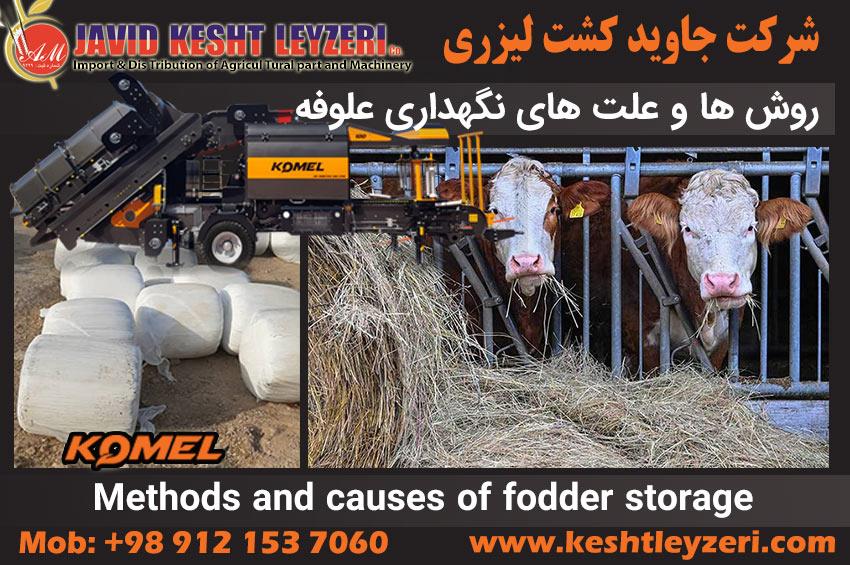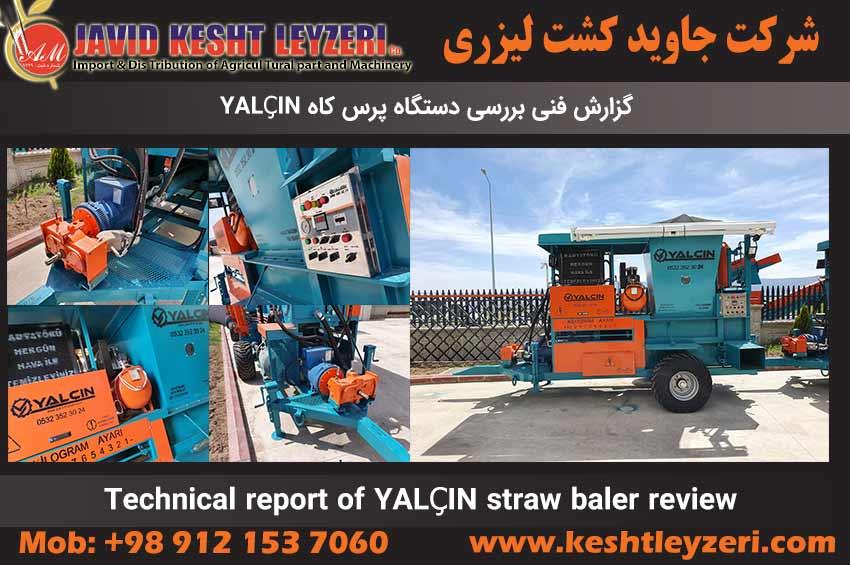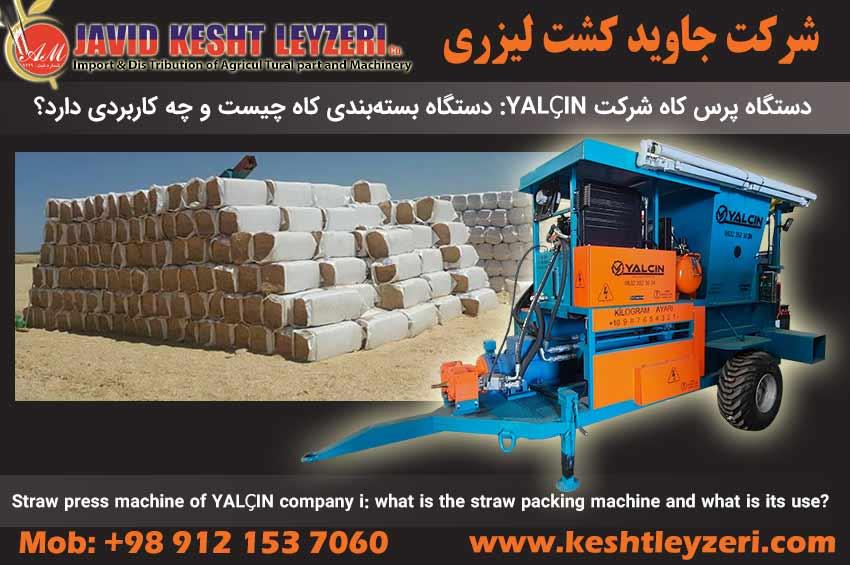
Methods and causes of fodder storage
javid keshtleyzeri Co.ltd
Fodder can be stored in different ways, although direct consumption of fodder and animal grazing in pastures is the most economical and correct method of feeding, but fodder and food must be stored locally for various reasons.
Among these reasons:
1- Plants grow in certain seasons and the maximum yield can be obtained from them, and since all the fodder is used for animal feed, the excess should be stored and kept for other times of the year when fodder production is minimal or nonexistent.
2- In free grazing, there is a risk of animals contracting parasitic diseases, the risk of animal bloat, the occurrence of pneumonia and joint diseases. In the case of feeding with dry or silage fodder, these risks do not exist.
3- If the animal's ration consists only of fresh fodder and pasture, sooner or later the animal will suffer from diarrhea, indigestion and flatulence, and to prevent this, the animal's ration should be made from more dry fodder or silage.
4- By picking and drying fodder when the nutritional value of plants has reached its maximum, the best fodder can be provided to livestock. Therefore, the purpose of keeping fodder is to preserve its nutritional properties and protect it from harmful factors. First of all, in the storage of fodder, one should try not to lose its nutrients and not to change its color and taste.
During fodder storage, the development of microbes should be prevented, and for this, the fodder storage environment should be selected in such a way that the life and reproduction of microbes is not possible.
In general, there are three common methods for storing fodder and food:
1- Natural drying of fodder
2- Drying in the shade, under the roof
3- Ensiling fodder, seeds, tubers, etc.
Natural drying of fodder
The best way to prepare animal fodder in temperate regions is to grow fodder for harvesting, drying fodder can be done in several ways:
- Drying in the field:
Fresh grass has approximately 70-80% water, but dry grass retains about 10% of its water. To dry and extract water from fodder, plant cells must first be killed so that they do not get the opportunity to absorb and consume the substances contained in them, which reduces the nutritional value of fodder.
For this purpose, new methods are available, but as experience has shown, the reduction of plant nutrients is directly dependent on the time that the fodder stays on the ground after being picked to lose its water. During this period, the drying rate of fodder depends on the duration of sunlight and air temperature.
If the ambient temperature is lower than 15 degrees or the humidity is higher than 60%, the fodder will not dry in open air. In any case, the grass should be harvested in sunny and warm weather, especially in the morning, so that a large amount of moisture is taken from it during the day. After drying the surface part, it should be turned immediately so that the lower parts are also dry.
The fodder is turned upside down with an iron fork or with special machines (rakes), this work is done in the afternoon. In hot and dry areas, on the second day after picking the grass early in the morning, it should be turned upside down. On the third day, the plant has lost almost half of its moisture and has completely withered and is drying up.
When the moisture content of the fodder is reduced to about 25%, it can be collected. If the dry fodder has more than 25% moisture, fermentation takes place in it, which leads to an increase in the temperature of the mass of grass, and as a result, it becomes rotten and black.
Practically, the time of collecting fodder is when if you wrap a bunch of grass in your hand, the branches are fragile, but the leaves do not fall all at once.
The dried fodder should be leafy - green - without mold and have a pleasant smell, it should also be free of mud, soil and foreign materials and be picked on time.
Using a special machine, dried fodder is cut into rectangular packages. Currently, packing fodder is one of the best ways to store dried fodder, because with this, a large amount of fodder can be compressed and packed in a small volume, taking up less space in the warehouse, as well as preventing the loss and shedding of grass leaves and quickly He collected fodder.
The weight and volume of the packages should be proportional to the strength and strength of the wire or thread used in the packaging, because if the weight of the package is high, the thread or wire may break when moving the package. They put them on top of each other and of course they cover it with tarpaulin or other coverings so that it is not damaged by wind and rain.
Drying of fodder in rainy places is done by hanging on tripods or on wires located inside the pasture.
- Drying fodder in the warehouse
This method is used in places where the summer heat is not enough to dry the grass and there is a possibility of rain.
After picking the fodder, it is placed in the open air for a day in the field until its moisture level reaches about 40%, then it is transported to the warehouses where cold or hot air flows so that the remaining moisture of the fodder is taken.
The hot air that is used to dry the fodder must pass quickly through the fodder in the warehouse. This air has low humidity and high temperature at the beginning of entering the warehouse, but when it leaves, the humidity level increases and the temperature decreases.
Drying of fodder in the barn should be done very quickly so that there is no chance of mold and damage.
When the moisture content of the fodder reaches 15%, the operation should be stopped and the fodder should be stored in covered places.
In some places, instead of blowing hot air, they use normal air and use big fans to blow the ambient air into the grass at high speed and dry the grass for 7-10 days. It is not necessary to dry the fodder in a specific building, but from any kind. A sheltered place can be used for this.
The floor of the warehouse is covered with wooden or iron grids, and the air flows through the grids into the grass, while a strong fan constantly introduces air into the space between the floor and the grids.
The value of dried fodder in warehouses
So that the experience shows that the carotene of the dried fodder in the barn is more than the carotene of the fodder that is dried in the field, and at the same time, the value of one type of fodder that is dried in the field and the other in the warehouse is different, and the dried fodder in the barn has more value, the fodder that is Store-dried fodder is usually harvested earlier than field-dried fodder, and therefore its quality will be higher and its cellulose content will be lower.
Cutting dry grass
One of the ways to preserve dry fodder is to grind (round and store) it. For this purpose, in a place close to the place where the animals live, they put fodder together in certain shapes.
Most of the Iranian farmers set up Taye at the entrance of the village and next to their houses. So far in our country, due to low rainfall and low labor wages, few people have thought of preparing a covered place to store fodder. The number of taye (its length and height) depends on the amount of harvested crop.
A taye must always have a certain volume and size and be applied in a dry and impenetrable place. A small hole should be built around the taye so that the water that comes down from the taye is collected in it and taken out.
Usually, taye is made in two shapes, one is round and the other is rectangular. Usually, they consider round taye for grain clusters and rectangular taye for fodder. In order to prevent the taye from returning in places where strong winds blow, farmers put a strong and long stick into the ground from the middle of the taye. To harvest fodder from the taye, you should always start from a direction that is not against the direction of the wind, because otherwise the wind will cause the hay to be messed up.
Usually, ventilators are installed in the middle of the taye to prevent it from heating up and at the same time keep it dry.
If we collect semi-moist fodder in a warehouse or in a haystack, fermentation occurs inside it, which is always accompanied by an increase in temperature, and this heat may lead to the spoilage of the fodder, and the oxidation that occurs inside the mass of grass causes its temperature to rise. to the point where there is a possibility of fire.
In order to prevent this damage, it is necessary to dry the fodder as much as possible, both in the barn and in the desert, and then dry it so that the temperature of the grass pile reaches about 71 degrees Celsius. and lower the temperature.
If the temperature is higher, i.e. around 79-85, there is a danger of fire and it is necessary to ask for help from the fire brigade before moving the fodder because it may help to ignite and ignite the fodder while moving and delivering enough air.
Fodder hangar
In places where rainfall and rainfall are almost high and early, it is difficult to prepare fodder and store fodder in an open area, and the product is not protected as it should be and it spoils quickly. The hangar is read and used.
The building of this warehouse is very simple and it is usually in the form of a rectangular hall, only its transverse parts are made of boards or simple construction materials, and its longitudinal sides are completely open. Its roof is covered diagonally with clay or shirani.
Today, large metal hangars are built, which are not only fodder storage, but also any livestock products and even agricultural machinery.
Grain grain storage
Cereal seeds are stored for different purposes (consumption or sale or for planting in the next year). If the seeds are wet, it is better to dry them completely with tools and then put them in the storage. If it is cheap to make a sack, it is better to keep it.
The warehouse should be made of cement or at least of plaster and brick and have enough windows to be completely ventilated so that the seeds do not smell. In the beginning, the seeds should be turned upside down once a day and later every few days, if the moisture content of the grain is less than 16%. If it is less and without dust, it can be stored in the warehouse for up to one year.
Certainly, fodder silage is one of the best methods with high shelf life, and in cases where high tonnage of fodder is involved, this method is the best and most effective method of storage. Do the work, you can see pictures and fodder packaging machines below:







